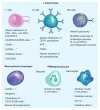Can peripheral leukocytes be used as Alzheimer's disease biomarkers?
- PMID: 19903022
- PMCID: PMC2828773
- DOI: 10.1586/ern.09.118
Can peripheral leukocytes be used as Alzheimer's disease biomarkers?
Abstract
Alzheimer's disease (AD) is the leading cause of dementia in elderly populations throughout the world and its incidence is on the rise. Current clinical diagnosis of AD requires intensive examination that includes neuropsychological testing and costly brain imaging techniques, and a definitive diagnosis can only be made upon postmortem neuropathological examination. Additionally, antemortem clinical AD diagnosis is typically administered following onset of cognitive and behavioral symptoms. As these symptoms emerge relatively late in disease progression, therapeutic intervention occurs after significant neurodegeneration, thereby limiting efficacy. The identification of noninvasive diagnostic biomarkers of AD is becoming increasingly important to make diagnosis more widely available to clinics with limited access to neuropsychological testing or state-of-the-art brain imaging, reduce the cost of clinical diagnosis, provide a biological measure to track the course of therapeutic intervention, and most importantly, allow for earlier diagnosis--possibly even during the prodromal phase--with hopes of therapeutic intervention prior to appreciable neurodegeneration. Circulating leukocytes are attractive candidate AD biomarkers as they can be obtained in a minimally invasive manner and are easily analyzed by widely available flow cytometry techniques. In this review, we critically analyze the potential utility of peripheral leukocytes as biological markers for AD.
Figures
Similar articles
-
Plasma neuronal exosomes serve as biomarkers of cognitive impairment in HIV infection and Alzheimer's disease.J Neurovirol. 2019 Oct;25(5):702-709. doi: 10.1007/s13365-018-0695-4. Epub 2019 Jan 4. J Neurovirol. 2019. PMID: 30610738 Free PMC article. Review.
-
Blood biomarkers as surrogate endpoints of treatment responses to aerobic exercise and cognitive training (ACT) in amnestic mild cognitive impairment: the blood biomarkers study protocol of a randomized controlled trial (the ACT Trial).Trials. 2020 Jan 6;21(1):19. doi: 10.1186/s13063-019-3798-1. Trials. 2020. PMID: 31907024 Free PMC article.
-
Graph Convolutional Network for AD and MCI Diagnosis Utilizing Peripheral DNA Methylation: Réseau de neurones en graphes pour le diagnostic de la MA et du TCL à l'aide de la méthylation de l'ADN périphérique.Can J Psychiatry. 2024 Dec;69(12):869-879. doi: 10.1177/07067437241300947. Epub 2024 Nov 25. Can J Psychiatry. 2024. PMID: 39584743 Free PMC article.
-
Saliva, an easily accessible fluid as diagnostic tool and potent stem cell source for Alzheimer's Disease: Present and future applications.Brain Res. 2020 Jan 15;1727:146535. doi: 10.1016/j.brainres.2019.146535. Epub 2019 Oct 25. Brain Res. 2020. PMID: 31669827 Review.
-
Harnessing peripheral DNA methylation differences in the Alzheimer's Disease Neuroimaging Initiative (ADNI) to reveal novel biomarkers of disease.Clin Epigenetics. 2020 Jun 15;12(1):84. doi: 10.1186/s13148-020-00864-y. Clin Epigenetics. 2020. PMID: 32539856 Free PMC article.
Cited by
-
Impairment of Several Immune Functions and Redox State in Blood Cells of Alzheimer's Disease Patients. Relevant Role of Neutrophils in Oxidative Stress.Front Immunol. 2018 Jan 11;8:1974. doi: 10.3389/fimmu.2017.01974. eCollection 2017. Front Immunol. 2018. PMID: 29375582 Free PMC article.
-
Machine Learning-Based Routine Laboratory Tests Predict One-Year Cognitive and Functional Decline in a Population Aged 75+ Years.Brain Sci. 2023 Apr 20;13(4):690. doi: 10.3390/brainsci13040690. Brain Sci. 2023. PMID: 37190655 Free PMC article.
-
Increased Aβ42-α7-like nicotinic acetylcholine receptor complex level in lymphocytes is associated with apolipoprotein E4-driven Alzheimer's disease pathogenesis.Alzheimers Res Ther. 2017 Jul 27;9(1):54. doi: 10.1186/s13195-017-0280-8. Alzheimers Res Ther. 2017. Retraction in: Alzheimers Res Ther. 2022 Jun 1;14(1):76. doi: 10.1186/s13195-022-01024-5. PMID: 28750690 Free PMC article. Retracted.
-
Leukocyte CCR2 expression is associated with mini-mental state examination score in older adults.Rejuvenation Res. 2012 Aug;15(4):395-404. doi: 10.1089/rej.2011.1302. Epub 2012 May 18. Rejuvenation Res. 2012. PMID: 22607625 Free PMC article.
-
Enrichment of risk SNPs in regulatory regions implicate diverse tissues in Parkinson's disease etiology.Sci Rep. 2016 Jul 27;6:30509. doi: 10.1038/srep30509. Sci Rep. 2016. PMID: 27461410 Free PMC article.
References
-
- Selkoe DJ. Alzheimer’s disease: genes, proteins, and therapy. Physiol Rev. 2001;81(2):741–766. - PubMed
-
- Hebert LE, Scherr PA, Bienias JL, Bennett DA, Evans DA. Alzheimer disease in the US population: prevalence estimates using the 2000 census. Arch Neurol. 2003;60(8):1119–1122. - PubMed
-
- Petersen RC. Challenges of epidemiological studies of mild cognitive impairment. Alzheimer Dis Assoc Disord. 2004;18(1):1–2. - PubMed
Publication types
MeSH terms
Substances
Grants and funding
LinkOut - more resources
Full Text Sources
Other Literature Sources
Medical
Research Materials

